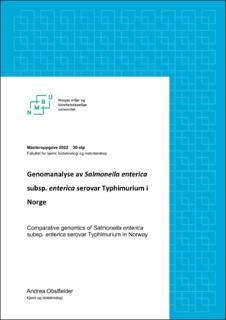| dc.contributor.advisor | Snipen, Lars Gustav | |
| dc.contributor.advisor | Lagesen, Karin | |
| dc.contributor.advisor | Sekse, Camilla | |
| dc.contributor.author | Obstfelder, Andrea | |
| dc.coverage.spatial | Norway | en_US |
| dc.date.accessioned | 2022-10-25T11:24:54Z | |
| dc.date.available | 2022-10-25T11:24:54Z | |
| dc.date.issued | 2022 | |
| dc.identifier.uri | https://hdl.handle.net/11250/3028173 | |
| dc.description.abstract | Salmonella enterica subspecies enterica serovar Typhimurium, referred to as S. Typhimurium in this master`s thesis, is one of the most common pathogenic serovariants of Salmonella spp. S. Typhimurium has been isolated in a wide range of hosts from the wild fauna. These hosts are believed to be responsible for several of the human cases of Salmonella infections in Norway. The main goal of this thesis is to test the hypothesis that wild animals are a potential source of infection from S. Typhimurium among production animals in Norway.
In this project a totalt of 127 S. Typhimurium isolates taken between 2001 and 2021 from wild animals, production animals and sport- and family animals were selected from the laboratory inventory at the Norwegian Veterinary Institute. The information present in the genome sequences of the S. Typhimurium isolates were examined using whole genome sequencing (WGS). WGS of pathogens is an important tool to improve the understanding of how contagious diseases spread between hosts. Due to limitations in the sequencing technology, the DNA are fragmented and only up to 300 bp are sequenced, this is then called reads. Bioinformatic tools were used for quality check a large number of the raw data from the sequencing before the original genom was attempted reconstructed using de novo SPAdes assembly.
” Multilocus Sequence Typing” (MLST) were used in further analysis to determine allele- variations based on 7 housekeeping genes, and each bacterial isolate were assigned one sequence type where ST19 and ST34 were the most common. Then the evolutionary similarity between isolates within the same ST was assessed by SNP analysis. Using phylogenetic analysis we were able to observe clusters with evolutionary similarity between wild animals and production animals, which indicates that transmission of S. Typhimurium had taken place. Based on the results from the applied dataset we found several of these cases, which gives a strong indication that wild animals can be the source of infection for S. Typhimurium among production animals in Norway. | en_US |
| dc.description.abstract | Salmonella enterica subspecies enterica serovar Typhimurium, omtalt som S. Typhimurium i denne masteroppgaven, er en av de vanligste patogene serovariantene av Salmonella spp. S. Typhimurium har blitt isolert hos et bredt spekter av verter fra villfaunaen som er antatt ansvarlig for flere av de humane smittetilfellene av Salmonella i Norge. Hovedmålet med oppgaven var å teste hypotesen om at ville dyr er en potensiell smittekilde for S. Typhimurium blant produksjonsdyr i Norge.
Det ble i dette prosjektet plukket ut totalt 127 S. Typhimurium isolater tatt mellom 2001 og 2021 fra ville dyr, produksjonsdyr og sport- og familiedyr fra laboratoriebeholdningen hos Veterinærinstituttet. Ved hjelp av helgenomsekvensering (WGS) ble informasjon som fantes i genomsekvensen til S. Typhimurium isolatene undersøkt. WGS av patogener er et viktig verktøy for å forbedre forståelsen av smittsomme sykdommer som sprer seg mellom verter. Begrensninger i sekvenseringsteknologien gjør at DNAet kuttes opp i kortere fragmenter, og kun korte fragmenter opp til 300 bp sekvenseres, også kalt reads. Ved hjelp av bioinformatiske verktøy ble store mengder rådata fra sekvenseringen kvalitetsjekket før det opprinnelige genomet ble forsøkt rekonstruert ved hjelp av de novo SPAdes assembly.
For videre analyser ble ” Multilocus Sequence Typing” (MLST) brukt for bestemmelse av allele-variasjoner basert på 7 husholdningsgener, og hvert bakterieisolat fikk tildelt en sekvenstype der ST19 og ST34 var mest vanlige. Deretter ble evolusjonær likhet mellom isolatene innenfor samme ST vurdert ved SNP analyse. For fylogenetiske analyser ble det observert klustre med en evolusjonær likhet mellom ville dyr og produksjonsdyr som indikerer smitteoverføring. Basert på resultatene fra det brukte datasettet var det i flere tilfeller sterke indikasjoner på at ville dyr kan være smittekilden for S. Typhimurium blant produksjonsdyr i Norge. | en_US |
| dc.language.iso | nob | en_US |
| dc.publisher | Norwegian University of Life Sciences, Ås | en_US |
| dc.rights | Attribution-NonCommercial-NoDerivatives 4.0 Internasjonal | * |
| dc.rights.uri | http://creativecommons.org/licenses/by-nc-nd/4.0/deed.no | * |
| dc.title | Genomanalyse av Salmonella enterica subsp. enterica serovar Typhimurium i Norge | en_US |
| dc.title.alternative | Comparative genomics of Salmonella enterica subsp. enterica serovar Typhimurium in Norway | en_US |
| dc.type | Master thesis | en_US |
| dc.description.localcode | M-KB | en_US |

